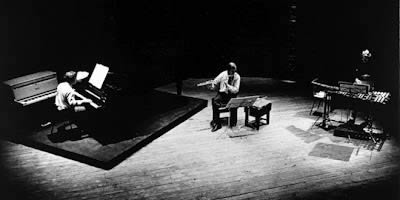Feldman’s Crippled Symmetry
|
Mike Silverton [November 2012.]
Morton FELDMAN: Crippled Symmetry / at June in Buffalo. Eberhard Blum, flute, alto flute, bass flute; Jan Williams, glockenspiel, vibraphone; Nils Vigeland, piano, celesta. Recorded live in 2000 at the UB Art Gallery, Buffalo, NY. Mastered by Denis Blackham. frozen reeds FR 001-2CD (two discs) (http://www.frozenreeds.com/). Distributed in the US by Forced Exposure (http://www.forcedexposure.com/). My devotion to Morton Feldman’s music looks in good measure to a number of splendid hatART CDs issued throughout the ’90s into the early 2000s. Whether modernist classical or off-center jazz (the latter occupying the bulk of the label’s catalog), Werner Uehlinger’s attention to performance and sound is impressive. Among my cherished Feldmans, a two-disc set, Why Patterns? and Crippled Symmetry (hatNOWseries CD 2-60801, 60802), occupies a special place, along with other of his long-duration compositions on hat, For Philip Guston and String Quartet (II) particularly. Also recommended: For Philip Guston, with Petr Kotik, Joseph Kubera, Chris Nappi (DOG W/A BONE DWA 802); For Philip Guston, with Julia Breuer, Matthias Engler, Elmar Schrammel (Wergo WER 6701 2); For Philip Guston, with Dorothy Stone, Arthur Jarvinen, Gloria Cheng Cochran (Bridge 9078 A/D), all four-CD sets; String Quartet (II), FLUX Quartet: Tom Chiu, Cornelius Duffalo, violins; Kenji Bunch, viola; Darrett Adkins, cello (mode 112, five CDs, also as one DVD). To return to the main event: The hatART instrumentalists for whom Feldman wrote Crippled Symmetry in 1983 recorded the work in co-production with West German Radio, Cologne, in 1990, along, as mentioned, with Why Patterns?. The performances, engineered by WDR’s Thomas Kern and Otto Fries, were mastered by hatART’s Peter Pfister: all told, marvels of transparency, luminosity and immediacy. With Feldman, decays — the delicate atmospheres among attacks — add immeasurably to the music’s purpose. I hear Crippled Symmetry as a late-20th-century masterwork — a perception arrived at under the spell of this synesthetic production. Little in music so calls to mind texture and color. For his lengthy, largely quiet works especially, recording is Feldman’s ideal vehicle. His interest in Abstract-Expressionist art and Turkish carpet patterns reveals itself in the music in a close to tactile manner. Werner Uehlinger first issued the set as a pair of jewel cases in an open-ended cardboard enclosure with an enormous (23-1/2 by 33-inch) fold-out, one side of which would make a dandy poster. (I’m tempted. I acquired a spare, how I’ll never remember.) Issued in 1991, the deluxe package was followed, again in ’91, by a half-as-expensive-to-produce set in one swing-out jewel case with an insertable fold-out. Same fine, extensive notes, in miniature. Reading glasses recommended. Crippled Symmetry / at June in Buffalo is the so far only offering of the Finnish label, frozen reeds. What an auspicious launch! In 2000 the work’s original soloists participated in “June in Buffalo,” a new-music festival Feldman established after he assumed a professorship at Buffalo University’s music department. The recording is of that performance. Perhaps I’m reading into what I hear: a trace of melancholy sentiment in a flawless execution — a mood I don’t detect in the beyond-meticulous studio performance. That would be fitting, given the venue and Feldman’s then-recent death in 1987. You may find my perception off the mark. I wonder about it myself. Beyond question or cavil is the recording’s value as an authentic event made permanent. The live recording lacks the studio recording’s exquisite resolution and transparency. Owing no doubt to how they were mic’d, Blum takes precedence over Williams and Vigeland’s relatively muffled parts. I would have loved to report otherwise. The hatARTs are out of print. The California EAR Unit (Dorothy Stone, flutes; Arthur Jarvinen, percussion; Vicki Ray, piano / celesta), Bridge 9002 A/B, issued in 1999, is available, as is the label’s entire catalog. Excellent recording, fine performance.
[More Mike Silverton]
[More
Feldman]
[Previous Article:
Graceful Illusionist: Gérard Pesson]
[Next Article:
Random Noise 34]
|
